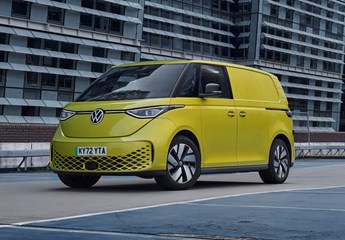- Orders open for Ineos Grenadier Commercial
- Toyota Hilux range gains new rally-inspired GR Sport II variant
- Remarketing: Pick of the bunch
- GA Commercial acquires first vans through Vanaways
- 'Luxury' tax on expensive pick-up trucks suggested
- ADVERTISEMENT FEATURE: Essential advice to avoid the van fleet ICE-berg
- ETRUX launches new Ford E-Transit Trizone
- Renault gives UK debut to Master E-Tech at CV Show
- Isuzu D-Max long-term test – Latest Report
- Isuzu D-Max V-Cross Steel Edition revealed
Volkswagen ID. Buzz Cargo (2022) review
Date: Wednesday, November 30, 2022 | Author: Sean Keywood

|
|
||||||
It’s difficult to think of many new vans that will ever have been more eye-catching than the Volkswagen ID. Buzz. With retro styling openly based on the classic T1 van, it’s the first ground-up EV from Volkswagen Commercial Vehicles, although it actually uses the MEB platform previously seen with several electric models in VW’s car range. Fresh from being crowned as International Van of the Year, it’s now arrived in the UK, and we’ve had the chance to sample the model here in right hand drive form.
Only one van bodystyle is available, alongside a five-seater car model, and although a longer-wheelbase version of the latter is expected next year, no such variant is planned for the Cargo.
A single powertrain is on offer, featuring a 204hp electric motor and a 77kWh battery, which delivers an official range of 256 miles with the entry-level Commerce trim, or 254 miles with the Commerce Plus we drove. The entry-level version also offers a slightly higher payload, at 607kg versus 592kg.
Compared with a short-wheelbase version of VW’s more conventional Transporter medium panel van, the ID. Buzz’s wheelbase is only 11mm shorter – although overall vehicle length is down by 192mm with that wheels-at-the-corners styling. Load volume for the ID. Buzz is 3.9m3 compared with 4.2m3 for the Transporter – although the latter model’s payloads range from slightly higher to much higher depending on spec due to its diesel powertrains. Perhaps more relevant, the ID Buzz’s electric rivals – the Mercedes-Benz eVito, and the Stellantis medium van family that includes the Vauxhall Vivaro Electric – both also beat it for load volume and payload, though they also bring drawbacks which we’ll return to later.
The ID. Buzz Cargo has good levels of interior and safety equipment, with technology taken from VW’s car range. A 5in Digital Cockpit display sounds small but it’s actually nicely optimised with relevant information, while the central 10in touchscreen is nicely responsive, and both features impressively high-def graphics. Unfortunately, the car range’s irritatingly fiddly audio and ventilation control touch sliders also feature.
Despite prestige car elements to the interior design, cabin trim is kept to hard-wearing plastics, with the exception of a synthetic leather steering wheel.
A fixed bulkhead is standard, but our test van featured an optional windowed version, which allows an eye to be kept on cargo and ensures that the interior rear-view mirror is actually useable (although it would be even more so if the headrest from the middle seat didn’t get in the way) when combined with our van’s optional windowed car-style single tailgate, although this is large and requires a decent amount of space to be left behind the van to open it – windowless rear wing doors are standard.
On the move the ID. Buzz Cargo is very quiet, which isn’t as obvious a statement as you might think – the sound of wind rushing past the mirrors can be distracting on some EVs, but not here, while the full bulkhead reduces noise coming through from the load bay.
With 204hp available acceleration is very sufficient and would be fast compared with a diesel van, although there isn’t the hot hatch-rivalling pace of the Ford E-Transit.
With its rear-wheel drive layout and car underpinnings the ID. Buzz Cargo is a very capable and secure handler, and despite the vehicle’s height it would take more vigorous treatment than is advisable on the public road to incur any loss of composure or anything in the way of body roll. Visibility is good, and a short front end helps with manoeuvrability – although seen from the side it’s not quite as slab-fronted as you might think, which presumably aids the model’s aerodynamics (VW claims a 0.29 drag coefficient), improving efficiency. Manoeuvrability is further helped by front and rear parking sensors and a reversing camera.
The ride did get a bit bouncy occasionally in our unladen test van, particularly on rough A-roads, but big bumps are softened nicely – a subsequent drive in the heavier, passenger-carrying ID. Buzz suggests things will be smoother when the van is loaded.
Overall, there’s a lot to like about the ID. Buzz Cargo, both on sight and from behind the wheel, but you may be remembering those load bay statistics from earlier and wondering if it’s a case of style over substance. Well, far from it. It may be less commodious than the eVito and Vivaro Electric, but the VW is significantly more powerful than both, and has a much greater driving range. Perhaps more surprisingly, and impressively, it’s also around £5,000 cheaper than the equivalent eVito, and more than £10,000 cheaper than the equivalent Vivaro Electric. Considering that, you’d have to say that even if this was a conventionally-styled van, it would have plenty going for it. Add back in those looks and the resulting potential image benefits for businesses that run them, and it’s a highly appealing package.
Volkswagen ID. Buzz Cargo Commerce Plus
Price (ex. VAT) £42,375
Price range (ex. VAT) £38,125–£42,375
Insurance group TBC
Warranty 3yrs/100,000mls (battery 8yrs/100,000mls)
Service intervals 2yrs/unlimited mileage
Load length 2,208mm
Load width (min/max) 1,217mm/1,230mm
Load bay height 1,330mm
Gross payload 592kg
Load volume 3.9m3
Engine size/power 204hp electric motor with 77kWh battery
Range 254mls
CO2 0g/km
VerdictCome for the showstopping styling, stay for the range and performance. |
9/10 |
|||
View The WhatVan Digital Edition


